Plants Are Not Created Equal
March 12, 2014 by admin
Filed under Garden Design, Perennials, Regional Gardening, Shade Gardening
Over the coming months I’ll be basing a number of blog posts, including this one, on material from my forthcoming book, The Shady Lady’s Guide to Northeast Shade Gardening. The official publication date is May 6, 2014. You can learn more about the book here, here and here.
In my last blog post I talked about a process of elimination I think gardeners should use in order to choose perennial plants for their gardens and why I believe that process will result in the best choices. The rationale behind it can be boiled down to a few simple words: plants are not created equal—at least not from an ornamental gardening standpoint. Some are much better garden performers than others.
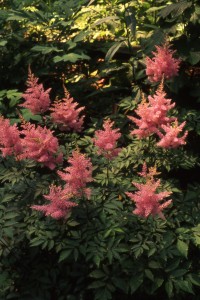
Astilbe is an excellent example of a backbone plant: it looks good all season and doesn't require tons of work.
It’s also important to realize that there’s no such thing as an ideal plant. You should no more expect perfection from a plant than a person, so you may have to give a little when it comes to your preferences.
Looking back at all the questions I said you should ask yourself when considering plants for your garden, I want to be clear that I’m not telling you there’s any plant for which all the answers will be what you want them to be. I’m just saying that for some plants a lot more of those questions have good answers, and those are the ones you should use to fill most of the space in your shade garden.
In fact, I have a name for these superior garden candidates: “backbone” plants. These are ornamentals whose exceptional qualities make them the best choices for filling the majority of the space in your garden. If you use them in abundance, they’ll hold your garden together and keep it solid, like a spine supports a body. Everything else, to one degree or another, is filler.
Strive to use backbone plants for at least 75-80% of your garden. Actually, you could build your garden from nothing but backbone plants, but for the sake of variety, you may allocate 15-20% of the space to secondary, filler plants that I refer to as “accent” plants. Finally, you can devote 5-10% of the space to a few annuals or tender perennials if you really feel the need to have them.
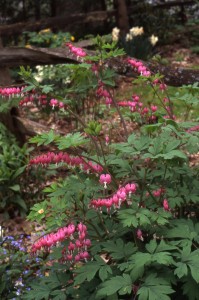
Old-fashioned bleeding heart is certainly a pretty face, but without staying power it doesn't qualify as a backbone plant.
So, what are some examples of backbone plants? I’ll give you two examples of backbone shade plants here, although this process of categorizing plants by their ability (or not) to deliver long-season performance applies equally well to sun as to shade.
The astilbe pictured above is a great example of a backbone shade perennial. It has strong, prominent flowers and attractive foliage, it’s not incredibly picky about growing conditions, it doesn’t require a lot of care, and it isn’t invasive. For those of us in the Northeast, its admirable cold hardiness is an essential quality, and the fact that deer generally ignore it is a godsend. Its only shortcoming is that it
really only flowers well in light shade at northern latitudes; in deep
shade, flowering will be minimal.
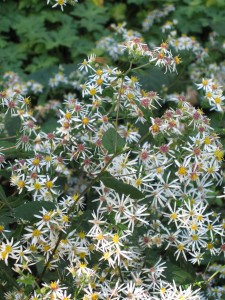
White wood aster is an underappreciated but very fine native backbone plant.
Plants like astilbe and white wood aster are reliable and unfussy—like friends who are easy to be with and always come through in a pinch. But you’ll notice that neither one gets “perfect marks.” As I pointed out earlier, it will almost never be the case that a plant perfectly suits all your needs and desires.
And they are not no-maintenance plants—there is no such thing in a garden setting. Each one has a rather predictable growth habit or behavior that will eventually demand your attention—astilbes often want division every few years, while white wood aster will migrate and have to be kept in bounds—but neither one will require an onerous amount of work. What they offer is a high likelihood of being successful additions to your garden, delivering steady results through the years while not making you regret ever planting them.
I know that this way of thinking about plants and plant selection may seem novel or even backwards to many readers. Gardeners are inundated with the message that gardening is all about personalizing your space and expressing your taste, not to mention the message that it should be cheap and easy, to boot (it generally isn’t, but that’s a topic for another blog post). While it’s certainly true that your garden should reflect your individuality, focusing too much on that obscures some inconvenient facts. Successful gardening means finding a manageable way to get good results given your budget of time and money, and for most homeowners that means putting functionality first.
I hope I’ve persuaded you of the value of using my approach. If you need a little more convincing, consider this: in the early years of my ornamental gardening experimentation, I bought a lot of plants I liked a lot and proceeded to…kill them. Mostly—because I was trying to determine the limits of their shade tolerance—I subjected them to inadequate light, and of course, a lot of them expired.
I feel kind of guilty about it now, but all that “horticide” did have a point: those sacrificial plants eventually taught me to categorize a wide range of shade perennials by both their needs and their performance potential for gardeners. In the process, I came to appreciate a whole new palette of plants for their ability to tough out the difficult conditions we Northeast shade gardeners face.
In my upcoming book, The Shady Lady’s Guide to Northeast Shade Gardening, I elaborate on the topic of what makes a superior shade garden perennial and how to use a wide range of shade plants to good effect. I hope that knowledge will help you find the best choices for your particular situation.
How (Not) to Pick a Plant
February 6, 2014 by admin
Filed under Garden Design, Perennials, Shade Gardening
Over the coming months I’ll be basing a number of blog posts, including this one, on material from my forthcoming book, The Shady Lady’s Guide to Northeast Shade Gardening. The official publication date is May 6, 2014. You can learn more about the book here, here and here.
When you pick perennial plants to put in your shade garden, how do you do it? Most people would start out by picking plants they like—and that’s where they’d make their first, and worst, mistake.
Huh? What? Surely I can’t be advising you to pick out plants you don’t like?! No, of course not. But think about this for a second. When you go shopping for a new car, do you just pick out the one you like the best? No—at least not if you’re like most of us. If that were all it took, we’d all be driving around in Ferraris and Lamborghinis. The problem with that approach is that most sports cars won’t do what most people need a car to do: get up a snowy hill on a winter day and deliver you to your job in one piece, or get enough miles to the gallon to not break the fuel budget.
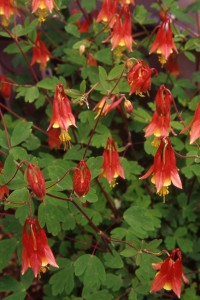
Flowers, flowers, we all like flowers—but there are many other important things to consider when choosing shade perennials.
In other words, we consider practical things. As weird an idea as this will seem to many people, you should do the same thing when you pick out plants—if you want your garden to look good with minimal effort and expense for the longest possible season.
Not all plants are equally good at doing that. In fact, for any given type of garden in any given region, only a small number of plants will give that kind of superior performance, in the same way that, in all likelihood, only a small number of cars will satisfy your criteria for budget and functionality.
So, what are the practical questions you have to ask when picking out plants? First, the more obvious ones:
• Is the plant cold hardy where I live?
• Does the plant prefer the conditions I can offer it?
It’s self-evident why these are questions you should ask first. It makes little sense to populate your perennial garden with plants that won’t be, well, perennial in your area. It also makes little sense to invest in plants that won’t be happy with the growing conditions you provide them. Matching plants to growing conditions is an essential part of the art of garden design. I’m not going to go into detail here about the fine points of that process; what matters is that you realize its importance.
What else do you need to ask yourself in order to pick the best perennials for shade? Here are a few more:
• Is the plant disease resistant?
• Is the plant prone to insect infestation?
• Is the plant unpalatable to deer and other potential browsers?
• Does the plant spread or seed aggressively?
• Does the plant typically go dormant before first frost?
• Does the plant have foliage that looks good all season long?
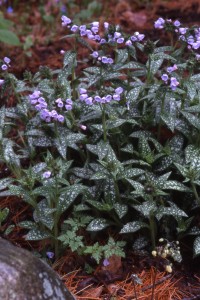
Powdery-mildew resistant Pulmonaria 'Roy Davidson'
The benefits of disease and pest resistance are obvious. Lungworts (Pulmonaria, see photo at left), for example, have unique speckled foliage that can brighten shady nooks and crannies, but most of them are prone to a disfiguring fungal disease called powdery mildew that leaves them coated with an unattractive whitish film. Luckily, some lungworts are resistant. If you buy only the resistant ones, you’ll be able to enjoy the beauty of disease-free lungworts, and you won’t have to expend extra effort to keep them that way.
It’s the same story for all the other questions above. By carefully selecting plants that aren’t palatable to most insect pests and browsing animals, you eliminate the need to take action to stop various critters from nibbling. Likewise, you reduce the need for work (and increase the percentage of your time in the garden devoted to enjoying it) by avoiding overly aggressive spreading plants.
Finally, as a general rule plants that perform well over a long season should be given priority over those that go dormant early or whose foliage declines in quality after flowering. Obviously, we’d all prefer a garden that looks full and good for the longest possible stretch of time.
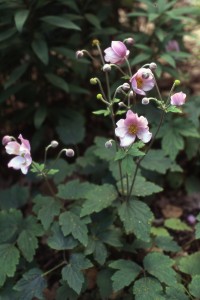
The long-flowering Japanese anemone cultivar 'Robustissima'
• Does the plant have attractive, prominent flowers? (Finally!)
• Do the flowers have a scent that’s nice, objectionable or simply absent?
• Do the flowers last a long time?
And there you have it: questions about flowers are in last place. Now, I want to clarify something. I understand perfectly why so many home gardeners give in to the temptation to fill their properties with plants having beautiful flowers. Beautiful flowers are lovely to look at—it’s as simple as that. The problem is that we don’t live in an ideal world. Flowers fade, and most perennials only produce flowers for two to three weeks every year under the best of circumstances. That’s not very long, so if you pick plants based on how well you like their flowers, you won’t get much bang for your buck.
I’m not saying that you should ignore a plant’s flowers when making choices. For instance, it is true that a small number of perennials will flower for a longer-than-average time, and can be worthwhile making room for these plants in your garden for that simple reason. One example is the Japanese anemone pictured above. I’m just saying that most of the time you should only be considering the flowers of plants that have passed muster in a lot of other ways first. Flowers should be your last consideration, not your first.
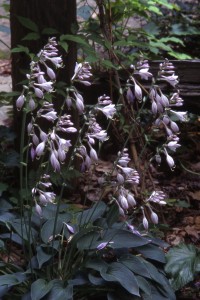
Cut these hosta flowers off? Not me!
In my next blog post, I’ll elaborate a little more on what makes a superior shade perennial and share a few examples.

